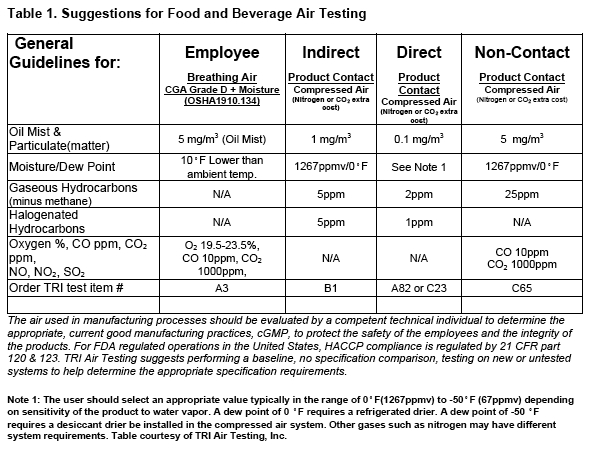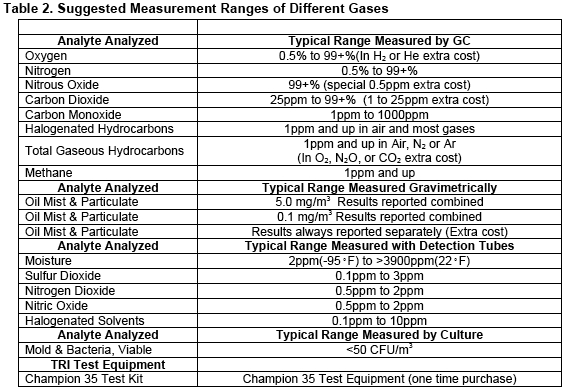In the 1970s, the use of filtration in air quality management in pharmaceutical production, hospitals, and medical device manufacturing facilities became increasingly important and increasingly of interest to regulatory agencies. The air quality field was growing. From the air moving into and out of clean rooms to the protection of surgical environments to the expansion of the global medical drug industry, compressed air began to play a larger role—a role that continues undiminished (and, in fact, has increased substantially) today. This helped spur larger growth in the compressed air field, including the use of air testing, which was already expanding due to attention in SCBA fire fighting and SCUBA diving air management and NFPA’s work with healthcare facilities moving into the 1980s.
However, one of the key aspects of compressed air management rests in understanding that there is a huge difference between how the use of compressed air is overseen in pharmaceutical or other facility types and how breathing air quality is regulated. Breathing air requirements can be defined narrowly by guidelines such as OSHA 1910.134 and CGA Grade D + Moisture. But the compressed air quality needed for operations like bottle blowing is not the same as for a facility that manufacturers implantable devices.
Today’s plant engineers must recognize this necessary inability to establish a “hard and fast” air quality standard beyond personal safety. And they must develop site-specific quality management and testing protocols that keep them in compliance with standards, even in the absence of exact standards for their applications, and operating efficiently. The pharmaceutical industry’s development has really provided a good template here.
The food and beverage industry has had a very similar arc in its compressed air usage. It too exists in something of a gray zone, despite the heavy quality controls in modern manufacturing. In food and beverage, the need for compressed air is enormous and the compressed air is or can be used in all aspects of production, transport and storage.
The site-specific nature of product-production air quality, however, has put food and beverage companies in a state of question. Compressed air is a significant source of facility energy consumption, which impacts operational efficiency and cost. It is also a point at which facility owners must evaluate the level of risk involved in any compressed air quality levels they use. In the absence of clear rules, beyond needing some repeatable protocol, they often shoot higher than needed.

Setting the Bar Too High
Mark Fenstermaker, Qualification Services Division Manager of Bethlehem, Pennsylvania-based Micro-Clean, Inc., notes that the questions about compressed air quality, particularly for issues such as oil and other non-viables, have grown as the FDA has dedicated more time to learning about compressed air practices in food and beverage facilities. Essentially, the FDA is looking at how facilities are monitoring their compressed air quality—what guidelines are plant engineers consulting, what guidelines are available to them, how are they gathering samples, how are they verifying the compressed air quality, etc.
It’s the same challenge as in the pharmaceutical field.
Fenstermaker says he’s seen an uptick in recent years in the number of food and beverage companies seeking out additional support for compressed air quality analysis. In addition to various testing services, Micro-Clean also provides training to multiple industries about the standards and guidelines available to them and how others in their sector are responding.
“If a company is involved with something like SCUBA gear,” Fenstermaker says, “they’re looking at positive pressure or suits or something like that. They have to do breathing air. They fall under certain regulations. But if they are a large beverage company—now the FDA is asking ‘Do they test?’”
They do, but the degree to which they test varies wildly. The FDA is looking at air that blows out bottles, for example, and making sure no contamination emanates from that compressed air source. But there’s no regulation specific enough to the application to follow.
“They have to determine their risk analysis,” Fenstermaker says. “What level of testing do they really want to perform at their location? A lot of them are taking the most stringent regulation they can find, like 8573-1, and they are using those recommended levels and testing to the lowest possible limit.”
This decision is increasingly common, but puts these operations at a fairly inefficient level of operation. ISO 8573-1, even at its lowest levels in oil and particulate control, is still far higher than food and beverage facilities generally need.
“In terms of oil testing,” Fenstermaker says, “they don’t have to be ‘0.000001’ or anything like that. For what they do, 0.01 may be perfectly appropriate, so long as the oil from their system is not contaminating the product.”
For food and beverage right now, oil contamination identification and prevention are key areas of air quality focus.
But Where Is Your Oil Coming From?
Oil contamination can be an extremely difficult contaminant to pinpoint when it is discovered in your compressed air system. Even brand new systems can yield oil contamination upon more detailed air analysis. Some common sources for potential contamination include:
Piping. “If it’s cast iron, for example,” says Fenstermaker, “maybe there was oil coating on the cast iron to protect it in storage….And if it wasn’t cleaned properly before assembling, now they have a contaminant in the line.” The fittings used to connect pieces of a compressed air system might have some sort of oil on them as well. As the flow continues through from the compressor system, the actual generator, it can release those contaminants. “That’s one of the main ways,” Fenstermaker says.
Oil-based compressors. Some compressors are oil compressors that require the input of oil for lubrication. With the constancy of this oil’s addition to the system, it increases contamination potential. Ways to test for it include Draeger tubes, air testing kits supplied by independent laboratories, and various analytical methods.
Lack of filtration. If the appropriate filtration, such as a point-of-use filter that may be beneficial to achieving an air quality goal, is not installed, oil can get pulled right into a compressor. It may sound simple, but it’s less so. Again, issues such as the type of piping or fittings and how they were stored may impact performance here. If the contamination is already in the pipes but you haven’t looked for it before, it may take you some time to figure out the source.
Contamination in the tanks. When you are dealing with massive industrial tanks at a food and beverage operation, it’s entirely possible that some contaminant is present in the tank. In this situation, even installing a new system will not correct the contaminants you are finding in your testing. The investment in new, clean piping, new compressors, new desiccant driers, and everything else will not yet help you meet your goals if turning the system on stirs up the pre-existing contaminants in your tanks.
The systems used on a commercial scale in food and beverage operations can be incredibly elaborate. From 200 gallon tanks to 5000+ gallon tanks, multiple compressors, multiple driers to lower dew points, etc., there are many points at which oil mist and particulate contamination can enter a system.
This is exactly why the FDA is asking about how facilities in this industry test the vast compressed air networks necessary to production.

This information has been shared courtesy of TRI Air Testing, Inc. (www.airtesting.com).
Outside Influence
While independent compressed air testing laboratories and consultants cannot tell you what you should do, their outside perspective can significantly help plant engineers identify where in the process the system is wasting energy and operational time or money to achieve a level of air quality that is well beyond industry practices. These independent partners can also help identify what type of contaminants, such as a particular level or type of oil has gotten into the product.
Sampling kits, such as those distributed by TRI Air Testing, Inc. in Austin, Texas help plant engineers economically acquire samples right at the source that are sent out for independent verification to a lab. Micro-Clean’s business model, in fact, provides not just its own testing capabilities but a close network of additional independent labs when analyses sought by companies require particular levels of analysis or an additional independent check.
It’s all part of fine-tuning in the food and beverage field, just as pharmaceutical facilities have done over the past 40 years.
“Oil is a big issue right now [in food and beverage],” Fenstermaker says. “Industry-wise, pharmaceutical is still the biggest area. But we are starting to get more calls from soft drink companies and other companies like that.”
Chris Kelsey writes for Geosynthetica on energy, engineering, and the environment. He would like to thank Mark Fenstermaker (www.microcln.com) and Dr. Ed Golla (www.airtesting.com) for sharing their time and insight.
To read more System Assessment articles, please click here.




